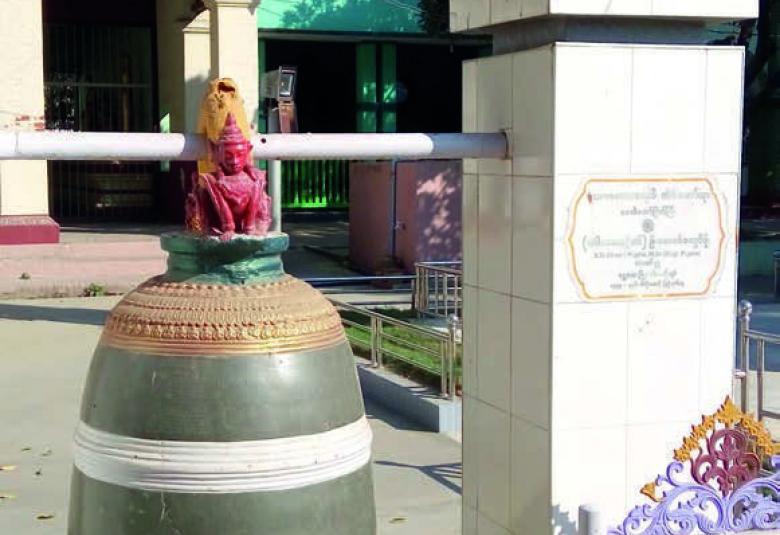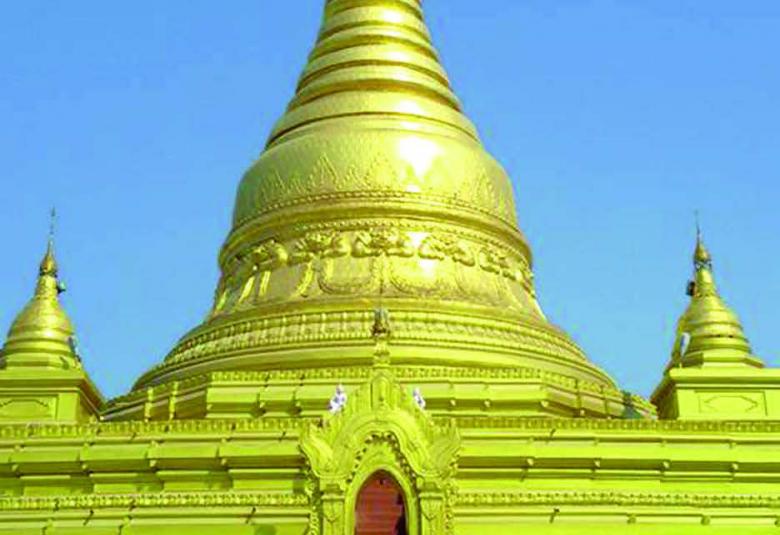By Maung Tha (Archaeology)
One of two Eindawya pagodas is located in Yangon and another one in Mandalay. Both pagodas were built by King Bagan (1846-1853 AD), the ninth king in Konbaung dynasty. The king built an Eindawya Pagoda in Maye Ward of Mandalay where he had resided in childhood and another one at the royal hut where he stayed in a short period during his tour of Dagon accompanying his father king. Both pagodas were famous as Eindawya more than original titles.
Mandalay Eindawya Pagoda
The precinct of Eindawya Pagoda on 87th street between 27th and 28th streets in Chanayethazan Township of Mandalay Region was the venue where King Bagan resided in his childhood. After succeeding to the throne of his father king on 17 November 1846, King Bagan himself laid cornerstones for construction of Eindawya Pagoda on 18 November 1847.
Four months after laying cornerstones, the king enshrined religious objects into the first reliquary and released 60 prisoners under amnesty on 18 March 1848.
A gold plate expressed with the scripts on the royal order of the king for his sons, grandsons and great grandsons to pay homage and maintain the enshrined objects and meritorious deeds was kept into the reliquary.
A missionary monk also kept a letter of sharing merits into the reliquary, requesting celestial beings to safeguard and maintain the pagoda not to be damaged throughout the Sasana era. Such letter was read at four dimensions of the pagoda. Construction of the pagoda was supervised by Secretary of Blacksmith Thatoe Mingyi Maha Minhla Kyaw Thu.
The Mandalay Eindawya Pagoda, 99 feet high, was fenced with double brick walls. The pagoda was 75 feet to the inner wall. King Bagan himself hoisted a holly umbrella atop the pagoda on 16 November 1848. The seven-tier umbrella was 13 feet and 10 inches in height and six feet in diameter. The pagoda was named Maha Lawkaranthi. Fifty-three prisoners were released under amnesty in commemoration of the successful completion of the pagoda.
In the precinct of the pagoda, four dignitaries—middle royal hall queen governor of Salin Thiri Tilawka Atula Yadana Devi, queen of father king governor of Salin, Hinthada governor who looked after the King Bagan in his childhood, and Granary Secretary Home Affairs Minister Maha Thettawshay—built each encircled pagoda at four inner corners.
Hsinmin Bridge also called Eindawya Elephant Bridge was located on Shwetachaung Canal near the east arch. Such bridge was built through the fund of Nagaraza white elephant captured from Kwinthaya Ward of Hanthawady in the reign of King Badon in 1806. The brick bridge was built on 22 February 1848 with two white elephant statues in east of the bridge.
Mikyaung Bridge stretching from the west of Eindawya Pagoda to Shwetachaung Canal was built on 14 December 1849. Both sides of the bridge were shaped with body structure of a crocodile and both sides of northern part created the head of crocodile. It was built by governor of Taungdwingyi Minye Kyawkhaung U Kyauk Lone. Two large lion statues can be seen in southern part of the bridge. Toe nails of the statues were made of marble donated by U Kyauk Lone.
A residential ward near the lion statues was called ChinthaeU Ward related to lion statues. Some said structures of two large lions at the foot of Mandalay Hill took samples from that of Mikyaung Bridge.
Historic Mahuya Maha Muni Buddha Image was located in southwest corner of Eindawya Pagoda’s precinct. The image was conveyed from Gaya of India in the reign of King Badon. It was kept in the prayer hall in Inwa. King Thayawady conveyed the image to Kuthodaw Lawkamunicula Pagoda in Zaungkalaw KanU of Amarapura. Two years after King Thibaw was taken away, the abbot of Mogaung Monastery and Officer of the Court U Poe Gyi conveyed the image into the precinct of Mandalay Eindawya Pagoda.
Princes and counsellors of the court built edifices at the pagoda. These buildings were reduced to ashes in outbreak of fire in 1910. Moreover, bomb blasts in the Second World War set the buildings ablaze except the pagoda and encircled ones.
Yangon Eindawya Pagoda
Maha Dhammaranthi Eindawya Pagoda is located on Myoma Kyaung Street, southwest of Shwedagon Pagoda, in Dagon Township of Yangon Region.
King Bagan allotted K 80,000 fund for building an Eindawya Pagoda in Yangon to Maritime Minister governor of Bago Maha Minkhaung Kyawhtin. He assigned the minister together with 1,400 troops to Yangon. The minister built over 71 feet high Eindawya Pagoda.
King Thayawady (1837-1846 AD) left Amarapura for Okkalapa (now Yangon) by Pyigyimon raft in 1841. The raft was docked near Lanmadaw jetty. The king went to the temporary royal palace built west of Shwedagon Pagoda. The route along which the king made his trip was named Lanmadaw that means the royal road.
Prince Bagan, who went along with the father king to Dagon, stayed at the temporary huts for princes. His temporary hut was in northeast of the temporary royal palace of the father king. When he came onto the throne, Prince Bagan built Eindawya Pagoda in the place of his temporary stay.
The Bago governor built four arches at four dimensions of the walls, a public rest house outside the walls which was south of the pagoda, a brick tank in front of the public rest house, a monastery for Khittaya abbot outside the walls, north of the pagoda, and an ordination hall outside the walls which was northeast of the pagoda. The pagoda was entitled Maha Dhammaranthi Eindawya Pagoda. Khittaya monastery, the ordination hall and the brick tank were destroyed in the Second Anglo-Myanmar War (1842- 1853 AD).
Before hoisting the umbrella atop the pagoda, a clash happened between Myanmar and British troops at Yangon Port on 12 April 1852.
Due to heavy attacks of British troops with supporting fire of bombs and cannons, the troops led by Pyay Shwedaung governor retreated to Shwedagon Pagoda.
Before arrival of British troops, the Bago governor quickly hoisted the umbrella atop Eindawya Pagoda. King Bagan himself hoisted the umbrella atop Mandalay Eindawya Pagoda but missed the chance to do so at Yangon Eindawya Pagoda.
The remaining fund was buried at southwest corner of the precinct.
A small pagoda was built on the place of the fund. Then, the Bago governor joined the Myanmar troops to fight against British troops at the west arch of Shwedagon Pagoda. As Myanmar lost to British in the war, information of Eindawya Pagoda in Yangon under control of British faded out. On 2 June 1947, Maha Dhammaranthi Eindawya Pagoda Board of Trustees was formed for the first time so as to maintain the pagoda.
In excavating ground pits to rebuild Sasana Linkara Monastery outside the walls, southwest corner of the pagoda, on 15 May 1984, a sitting Buddha image, 7.5 inches high, was found there.
The image was made with posture of left hand kept on the left thigh and right forefinger pointing to the ground. Moreover, nine ancient ceramic dishes with five inches in diameter and about 2.5 inches in height, an ancient betel tray and a large glazed pot were also found. Abbot U Vayama of Sasana Linkara Monastery has been preserving these items.
There were other famous Eindawya pagodas in Myanmar history similar to those in Mandalay and Yangon. One month after ascending the throne, King Badon built Aungmye Lawka Eindawya Pagoda in Sagaing on 20 March 1782. Likewise, King Thayawady built Lawka Zeya Eindawya Pagoda in the place of Mingala royal palace at Yekin Mingyi Monastery in Thayawady on 22 January 1842 and hoisted a holly umbrella atop it.
Title of Mandalay Eindawya Pagoda, Maha Lawkaranthi means the great ray for the world as well as Yangon Eindawya Pagoda’s title Maha Dhammaranthi, the ray of Dhamma. Over 160 years old two ancient Eindawya pagodas are crowded with pilgrims daily till today.
Translated by Than Tun Aung Reference:History of Maha Dhammaranthi Eindawya Pagoda
Myanmar Encyclopaedia Volume (15)





